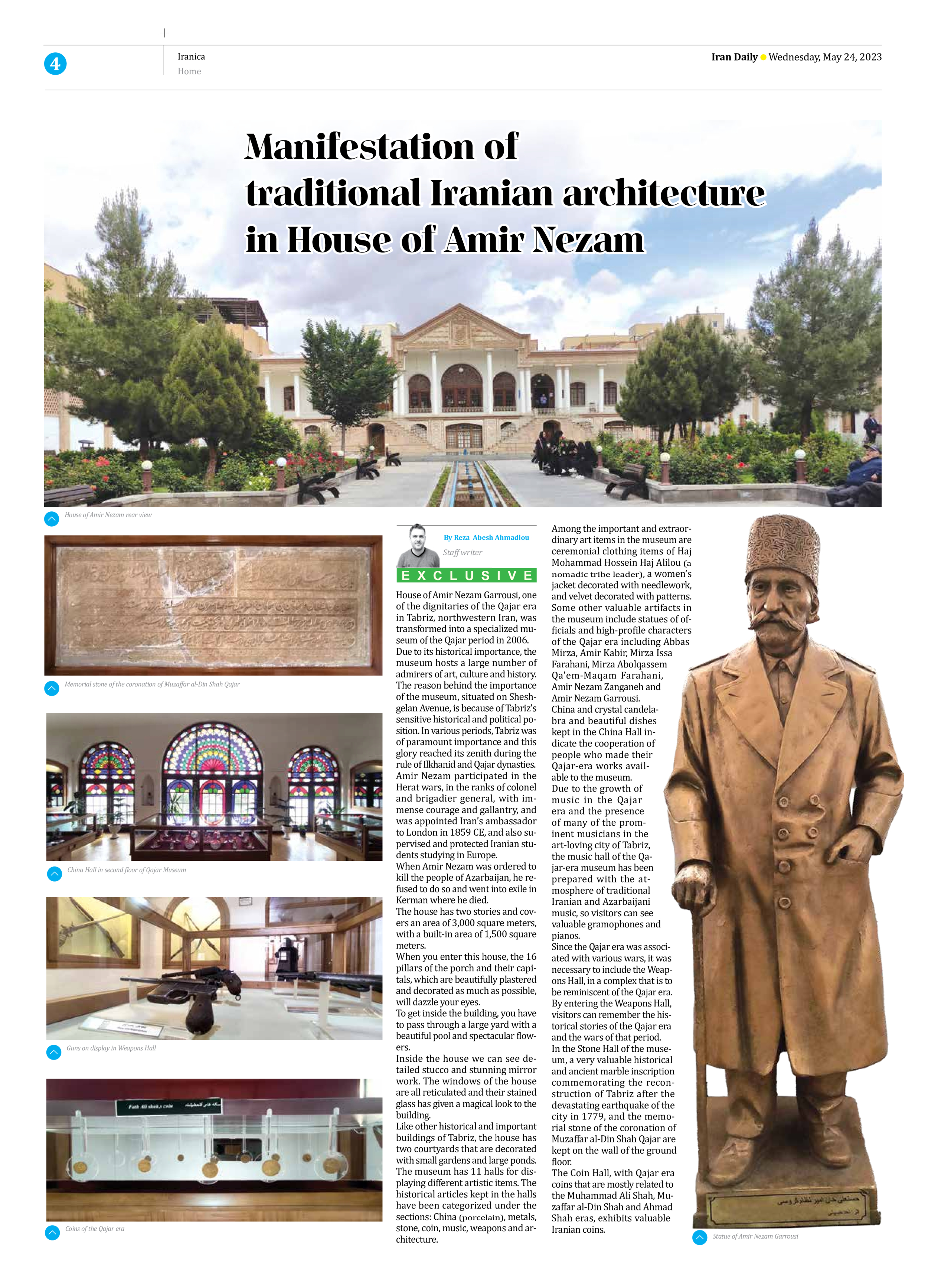
Manifestation of traditional Iranian architecture in House of Amir Nezam
By Reza Abesh Ahmadlou
Staff writer
House of Amir Nezam Garrousi, one of the dignitaries of the Qajar era in Tabriz, northwestern Iran, was transformed into a specialized museum of the Qajar period in 2006.
Due to its historical importance, the museum hosts a large number of admirers of art, culture and history.
The reason behind the importance of the museum, situated on Sheshgelan Avenue, is because of Tabriz’s sensitive historical and political position. In various periods, Tabriz was of paramount importance and this glory reached its zenith during the rule of Ilkhanid and Qajar dynasties.
Amir Nezam participated in the Herat wars, in the ranks of colonel and brigadier general, with immense courage and gallantry, and was appointed Iran’s ambassador to London in 1859 CE, and also supervised and protected Iranian students studying in Europe.
When Amir Nezam was ordered to kill the people of Azarbaijan, he refused to do so and went into exile in Kerman where he died.
The house has two stories and covers an area of 3,000 square meters, with a built-in area of 1,500 square meters.
When you enter this house, the 16 pillars of the porch and their capitals, which are beautifully plastered and decorated as much as possible, will dazzle your eyes.
To get inside the building, you have to pass through a large yard with a beautiful pool and spectacular flowers.
Inside the house we can see detailed stucco and stunning mirror work. The windows of the house are all reticulated and their stained glass has given a magical look to the building.
Like other historical and important buildings of Tabriz, the house has two courtyards that are decorated with small gardens and large ponds.
The museum has 11 halls for displaying different artistic items. The historical articles kept in the halls have been categorized under the sections: China (porcelain), metals, stone, coin, music, weapons and architecture.
Among the important and extraordinary art items in the museum are ceremonial clothing items of Haj Mohammad Hossein Haj Alilou (a nomadic tribe leader), a women’s jacket decorated with needlework, and velvet decorated with patterns.
Some other valuable artifacts in the museum include statues of officials and high-profile characters of the Qajar era including Abbas Mirza, Amir Kabir, Mirza Issa Farahani, Mirza Abolqassem Qa’em-Maqam Farahani, Amir Nezam Zanganeh and Amir Nezam Garrousi.
China and crystal candelabra and beautiful dishes kept in the China Hall indicate the cooperation of people who made their Qajar-era works available to the museum.
Due to the growth of music in the Qajar era and the presence of many of the prominent musicians in the art-loving city of Tabriz, the music hall of the Qajar-era museum has been prepared with the atmosphere of traditional Iranian and Azarbaijani music, so visitors can see valuable gramophones and pianos.
Since the Qajar era was associated with various wars, it was necessary to include the Weapons Hall, in a complex that is to be reminiscent of the Qajar era.
By entering the Weapons Hall, visitors can remember the historical stories of the Qajar era and the wars of that period.
In the Stone Hall of the museum, a very valuable historical and ancient marble inscription commemorating the reconstruction of Tabriz after the devastating earthquake of the city in 1779, and the memorial stone of the coronation of Muzaffar al-Din Shah Qajar are kept on the wall of the ground floor.
The Coin Hall, with Qajar era coins that are mostly related to the Muhammad Ali Shah, Muzaffar al-Din Shah and Ahmad Shah eras, exhibits valuable Iranian coins.







